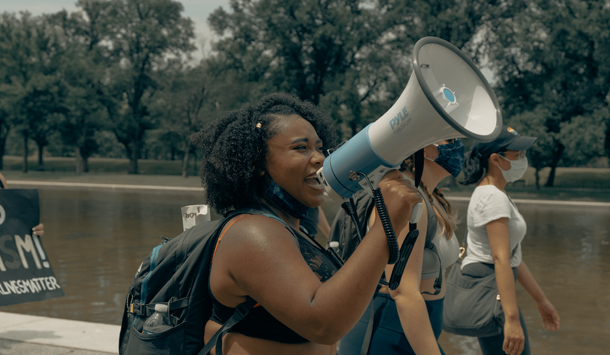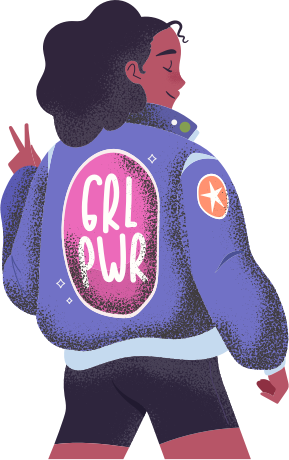by Emma Bloomfield
Black History Month is both a time for celebration and introspection, a moment to honour achievements while also exploring how we can ensure Black history is recognised and celebrated all year round.
This October has been an especially engaging one for me, Emma Bloomfield, Head of Community Engagement and Outreach at GirlDreamer. I’ve spent the month attending a range of community events exploring race, gender, and the sociopolitical issues that deeply intersect with the experiences of women of colour, the very heart of the GirlDreamer community.
From events on Black British Girlhood and how it shapes creative communities, to Pan-African feminist gatherings exploring how the movement carries forward in shared spaces, I’ve attended over ten events that collectively showcase the many ways our communities continue to fight for freedom, justice, and equality across sectors.
Through these experiences, three key learnings have emerged that I want to share with you.
1. DEI Pullbacks Are Being Felt Across the Sector
At Black Tech Fest, I attended a session unpacking the current regression in Diversity, Equity and Inclusion (DEI) efforts. It offered raw and honest reflections on why many organisations are stepping back, and what this reveals about the broader system.
The surge in corporate and institutional DEI commitments following the 2020 Black Lives Matter movement created a moment of unprecedented visibility and investment. Yet, as discussed during the session, much of that momentum was rooted in performative optics rather than genuine equity. The so-called “business case for DEI” was described as a façade, one that served profit and popularity more than justice.
Now, as we navigate an increasingly constrained funding landscape, organisations are having to confront the reality that true equity work demands more than gestures. It requires sustained commitment, accountability, and an honest reckoning with power.
2. Community Events Are Sustaining and Pushing Movements Forward
Community spaces continue to be the lifeblood of our movements, creating hubs for activists, artists, and organisers to connect, reflect, and reimagine.
At Love Letters to Our People: Writing Pan-African Feminist Histories at the Feminist Library, I was moved by being in a room full of thinkers and doers — activists, community organisers, and researchers — all dedicated to propelling the diasporic movement forward.
Similarly, at the SING SING screening, panelist and theatre director Phillip Morris underscored the urgent need for communities to build systems outside of systems of oppression, a reality that has long defined Black resilience. He reflected on how, during the age of austerity in the UK, marginalised communities have been forced to reimagine survival and solidarity beyond state structures.
This is not new. From the Windrush generation creating Saturday schools to teach Black history, to youth clubs and community centres that once offered vital spaces for empowerment, our communities have always found ways to thrive beyond exclusion. But as these spaces disappear due to chronic underfunding, the impact on youth culture has been profound.
Organisations like Trybe House Theatre and Black Boys Theatre Club are now carrying that legacy forward, using art and storytelling as tools to challenge the school-to-prison pipeline and help young Black people find creative, empowering pathways to success both inside and outside institutional walls.
3. Art as Transformation, Storytelling, and Resistance
Art continues to be one of the most powerful tools of transformation within the Black community, a way to reclaim narratives, express identity, and carve out pathways of resistance and healing.
At the Black and Bi Curious event, activists and creatives explored how media and culture can challenge the negative stereotypes that often distort the experience of being both Black and bisexual. At Black British Girlhood, artist Hillarynx reflected on the power of art as both pedagogy and protest, a way to teach equity and transmit the principles of Black feminism. She echoed Nina Simone’s belief that “it is an artist’s duty to reflect the times.”
Even the art of hairstyling is being reclaimed as an act of storytelling, a living archive of culture, expression, and defiance against the historic policing of Black bodies. Many Black women today are embracing multifaceted creative paths, using art and freelancing as a means to affirm identity, protect wellbeing, and resist institutional exclusion.
Looking Back to Move Forward
These learnings offer important insights for communities like GirlDreamer, reminding us of the role we play in providing safe, affirming spaces where women of colour can build, heal, and lead. They also show us how Black history, when told through the lens of empowerment and resilience, becomes a tool for safeguarding our communities amid rising anti-immigrant sentiment and DEI regression.
Two powerful themes emerged from this year’s Black History Month:
- Ubuntu — “I am because we are”: a philosophy grounded in empathy, connection, and collective care, showing how Pan-African solidarity continues to live through us.
- Sankofa — “Looking back to move forward”: a call that reminds us that understanding our history is essential to shaping an equitable future.
Black History Month may last one month, but its lessons, of resilience, creativity, and community, continue to guide how we dream, act, and build together all year round.




